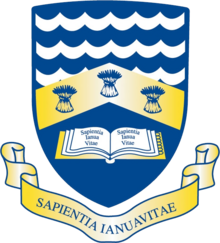Wirral Grammar School for Boys
 |
|
| Motto |
Latin: Sapientia Ianua Vitae (Wisdom is the Gateway to Life) |
|---|---|
| Established | 1931 |
| Type |
Grammar school; Academy |
| Headteacher | D.R. Hazeldine |
| Senior Deputy Headteacher | K.T. Taws |
| Chair of Governors | Mrs S Clarke MBE |
| Location |
Cross Lane Bebington Merseyside CH63 3AQ England Coordinates: 53°22′03″N 3°09′47″W / 53.3675°N 3.163°W |
| Local authority | Wirral MBC |
| DfE number | 344/5401 |
| DfE URN | 137476 Tables |
| Ofsted | Reports |
| Staff | 120 |
| Students | 1077 |
| Gender | Boys |
| Ages | 11–18 |
| Houses |
Barber Dodds Hodgson Lever |
| Colours | Black Blue |
| Publication | Nuntius |
| Website | WGSB |
Wirral Grammar School for Boys was founded in 1931 as a maintained selective grammar school for boys aged 11–18. It is situated on a 9.1 acres (3.7 ha) site to the west of Port Sunlight at Cross Lane, Bebington, on the Wirral Peninsula in England. The current headmaster, David Hazeldine, has been in post since 2006. Academically successful, the school was placed 42nd in the top 100 in the Daily Telegraph 'A' level table in 2015. and 145th in the DfE GCSE table in the same year) but has not been inspected since its conversion to academy status. The school's main claim to fame lies in being the alma mater of former Prime Minister of the United Kingdom Harold Wilson, who was a member of the sixth form from 1932 to 1934 and was the school's first Head Boy.
On 23 March 1925, Cheshire County Council passed a resolution to build a new secondary school in Bebington. Designed by the County architect, F Anstead Browne, the new school was opened by the Lord Lieutenant of Cheshire, Brigadier-General Sir William Bromley-Davenport on 26 September 1931.
The school was administered by Cheshire County Council until the council was dissolved in 1974; since then it has been administered by Wirral Metropolitan Borough Council, which maintains use of the 11+ for senior school admission.
In 2008 the borough council resolved to replace mobile classrooms with a brick building for the mathematics department, business studies facilities, some history and geography rooms, an extra Modern Foreign Languages room, additional science laboratories, a new music centre and several ICT suites. There is now an exterior science area (including a greenhouse), and refurbishment of the main building included two sixth form history and politics classrooms. An entrance atrium, where exhibitions of pupils' work are held, is part of the new development.
...
Wikipedia
